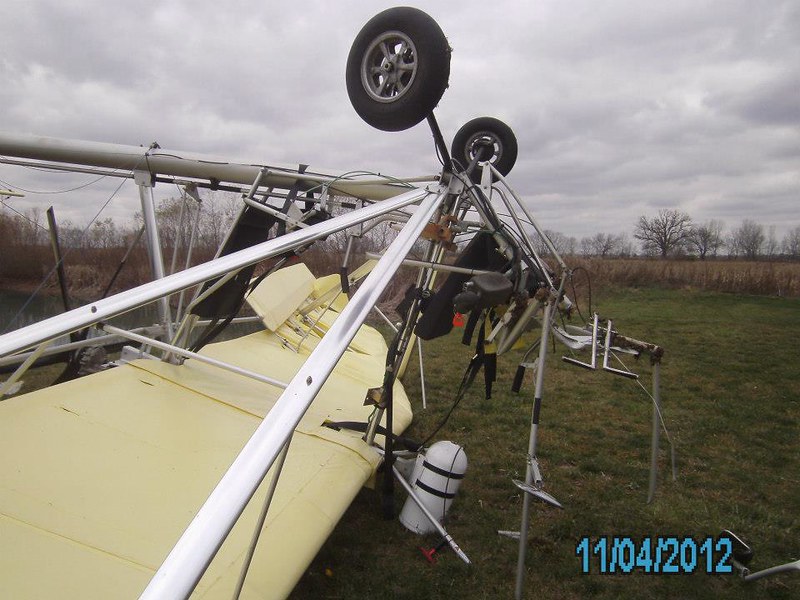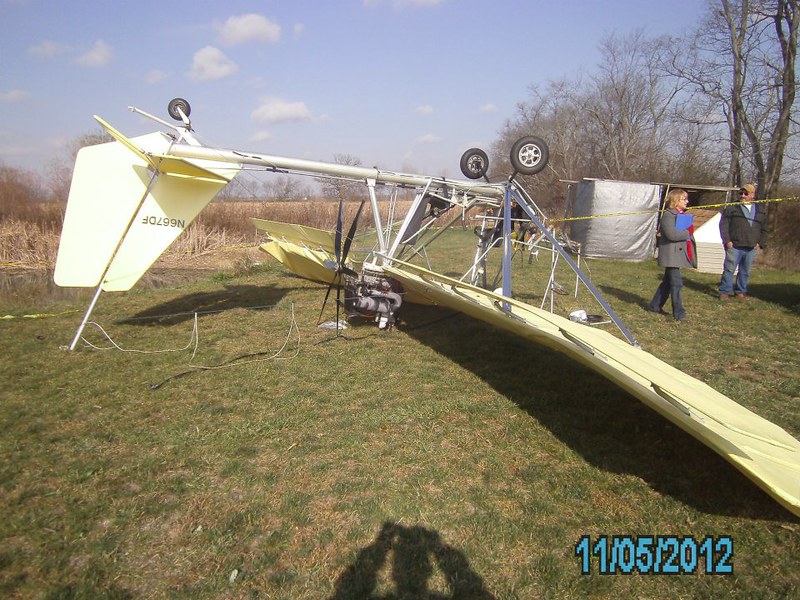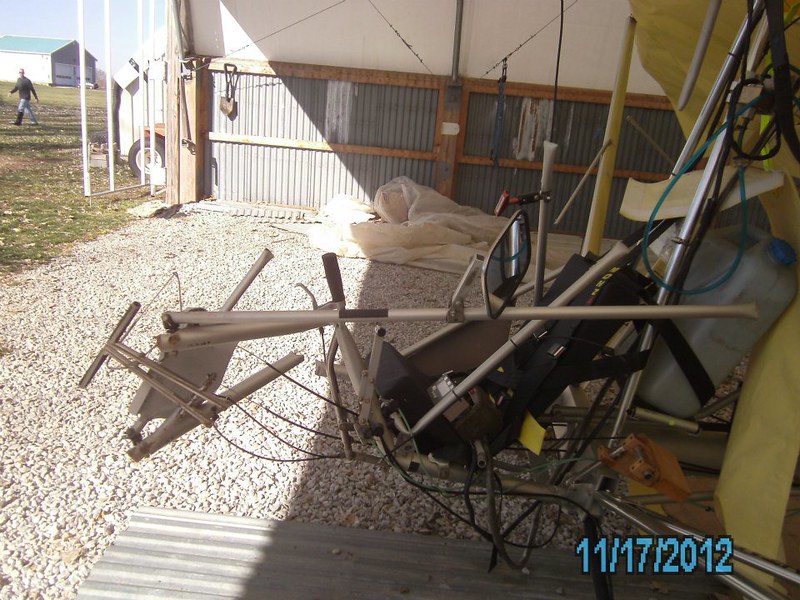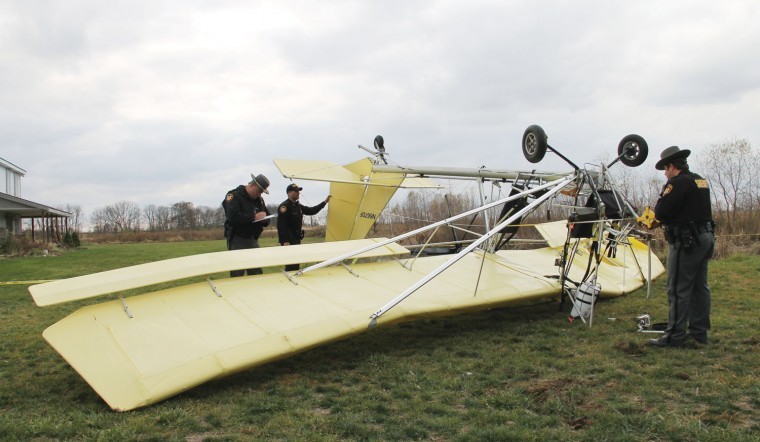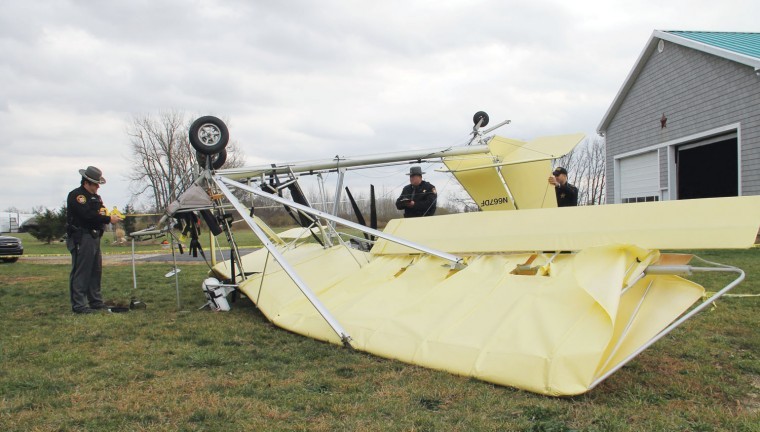http://www.hanggliding.org/viewtopic.php?t=27809
Tug accident in Ohio
Jim Gaar - 2012/12/19 19:17:01 UTC
This is preliminary information, subject to change, and may contain errors. Any errors in this report will be corrected when the final report has been completed. NTSB investigators may not have traveled in support of this investigation and used data provided by various sources to prepare this aircraft accident report.
On November 4, 2012, about 1245 eastern standard time, a Dragonfly-C, N667DF, experienced a total loss of engine power during takeoff, and collided with terrain near Darbyville, Ohio. The pilot, the sole occupant of the aircraft, received minor injuries. The aircraft received substantial damage to both wing spars and the vertical stabilizer. The aircraft was registered to a limited liability corporation and operated by an individual under the provisions of 14 Code of Federal Regulations Part 91 as a personal flight. Visual meteorological conditions prevailed for the flight, which operated without a flight plan. The airplane had just departed the WesMar Aerodrome, Orient, Ohio.
According to a statement provided by the pilot, the airplane was towing a hang glider, and was about 80 feet above ground level when the engine stopped producing power. The hang glider was released and the pilot attempted to perform a forced landing. The engine was retained for further examination.
Steve Baran - 2012/12/19 19:39:28 UTC
The usual cause of such a shut down when I flew ULs back in 70s/80s was lack of fuel due to fuel line shut off (never turned on and engine was only running a short time prior to takeoff). Water in fuel tank can also cause same - especially in winter due to condensation. I also remember a faulty kill switch issue cropping up at one time causing loss of power. Never experienced these myself but saw each happen.
Glad pilots are reasonably OK.
Added .... As for loss of power results ... If most of what produces drag is above the center of mass the craft's nose will rotate upwards. At 80 feet off the ground this can be problematic (stall) - and exaggerated if climb angle is high. Also doesn't help if tug is already over an area where a dead stick landing can't be made safely. I hope we learn more about the entire cause and ensuing consequences.
Jim Gaar - 2012/12/19 20:22:49 UTC
Ahh thanks. Good to hear the causes!
Looks very similar to our tug accident after getting waked by another GA aircraft that had just done a touch and go.
Steve Baran - 2012/12/19 20:25:26 UTC
Interesting, never have flown a water cooled UL. Would a remedy have been to run the engine up a few times prior to takeoff and/or taxi around a bit?
Looks like the vertical rudder extension may have helped lessen prop damage.
Brad Barkley - 2012/12/19 20:32:49 UTC
Frostburg
I'm glad to know everyone involved survived!!

Dave Hopkins - 2012/12/19 22:25:55 UTC
Seems the front cage doesn't offer much of a crumple zone for the pilot. When it folds you are in for a bruising. It's good to have small wheels or skids so the cage doesn't dig in if the nose goes down.
Craig Hassan - 2012/12/19 22:34:43 UTC
Letting the engine warm up slow is key. Then you have to let the thermostat open and ALL of the water heat up.
Same thing can happen on cold days if you go to idle and take a long slow decent, or nose down and dive. At idle the thermostat won't open enough and the water in the radiator will cool too much. Hit the throttle and bam! It is not a sputter and die. There is no partial power loss. It is lights out for the engine. I'm told it leaves a tell tale scarring on piston and sleeve.
I think I read somewhere you can run a bypass of some sort so there is always a bit of water circulating. This helps keep the water in the radiator from cooling to much.
This is actually the second accident for our tug. First time the bridle got draped in front of the elevator. On roll out it caught in the tailwheel and wound up. It pulled, and locked, the rudder in a full deflection.
Happily our tug pilot walked away both time with little to no injuries. Sadly he may be done being our tug pilot. He has been a huge, HUGE part of our club. Not sure where that leaves us. Waiting on insurance and tug owners to decide. Talk of a couple ultralight tugs, but we will see.
Dennis Wood - 2012/12/19 22:38:04 UTC
Suffolk, Virginia
i've often wondered about a welded chrome moly cockpit for the D-fly. i don't think the weight would be that prohibitive, but not all assembly men are versed in TIG welding.
Dan Harding - 2012/12/19 22:40:13 UTC
Burlington, Washington
Thermostats do not just open to full, or close quickly, unless they are faulty. It is unfortunate that a part as vital as that can not be preflighted. I have seen new thermostats not work as they should and have replaced the radiator because of a bad one.
On November 4, 2012, about 1245 eastern standard time...
So how come we're just hearing about this now?
a Dragonfly-C, N667DF, experienced a total loss of engine power during takeoff...
DUDE!!! A TOTAL loss of engine power during TAKEOFF!!! What an unimaginably horrible experience that must've have been!
...and collided with terrain...
I don't understand. Why didn't he just land?
...near Darbyville, Ohio.
Wings to Fly!
The pilot, the sole occupant of the aircraft...
Who's remaining nameless because?
...received minor injuries.
Bummer.
The aircraft received substantial damage to both wing spars and the vertical stabilizer.
GOOD. That goddam plane and the total douchebags who developed and fly it constitute one of the worst disasters ever to befall hang gliding.
According to a statement provided by the pilot, the airplane was towing a hang glider...
Who, by the way, under the right set of circumstances could've also been seriously fucked up as a direct consequence of this engine failure.
...and was about 80 feet above ground level when the engine stopped producing power.
Try having your Dragonfly mandated standard aerotow weak link blow ten feet off the cart and see how much you like it - motherfucker.
The hang glider was released and the pilot attempted to perform a forced landing.
BOTH pilots had to deal with forced landings. But that's pretty routine for us - motherfucker.
The usual cause of such a shut down when I flew ULs back in 70s/80s was...
Not much fun whatever the cause - is it, ChattaroyMan?
Also doesn't help if tug is already over an area where a dead stick landing can't be made safely.
None of these things are safe. They're all deviations from the flight plan and the FAA defines them - for planes at both ends of the string - as EMERGENCY landings.
The engine was warmed up, but left to sit for to long before the tow.
So pilot error. Right, Craig?
Photos were taken shortly after by the pilot's wife. She posted them to facebook.
Give her a kiss for me. They're GOLDEN.
Looks like the vertical rudder extension may have helped lessen prop damage.
Given what idiot fucking Bobby Bender Bailey designed it to do - AMAZING.
I'm glad to know everyone involved survived!!
Sure. Why not?
Seems the front cage doesn't offer much of a crumple zone for the pilot.
Neither, apparently, does the airframe of a North Wing T2 after the tug does to him what this engine did to this guy. Just ask Jeremiah Thompson's next of kin.
This is actually the second accident for our tug.
That's not even the first "accident" for your tug, Craig.
Sadly he may be done being our tug pilot.
Yeah Craig, I got tired of wondering if I was going to get dumped every time I took off too. Pretty shitty way to run an airline.
He has been a huge, HUGE part of our club.
Fuck your idiot club.
Not sure where that leaves us.
Hopefully grounded - right where you assholes deserve to be.
i've often wondered about a welded chrome moly cockpit for the D-fly.
Maybe the focus should be more along the lines of making sure nobody ever loses power on takeoff - 'cause not all losses of power on takeoff are survivable no matter how good your welders are.
